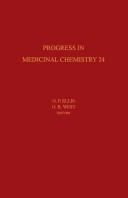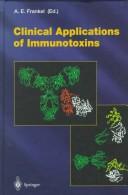| Listing 1 - 6 of 6 |
Sort by
|
Book
ISBN: 3038972495 3038972487 Year: 2019 Publisher: MDPI - Multidisciplinary Digital Publishing Institute
Abstract | Keywords | Export | Availability | Bookmark
 Loading...
Loading...Choose an application
- Reference Manager
- EndNote
- RefWorks (Direct export to RefWorks)
Ribosome inactivating proteins (RIPs) form a vast family of hundreds of toxins from plants, fungi, algae and bacteria. RIP activities have also been detected in animal tissues. They target a single adenine of a ribosomal RNA, thereby blocking protein synthesis and leading intoxicated cells to apoptosis. The role of plant RIPs may be related to plant defense against predators and viruses, plant senescence or bacterial pathogenesis. Most RIPs are no threat to human or animal health. However, several bacterial RIPs are major virulence factors involved in severe epidemic diseases such as dysentery or the hemolytic uremic syndrome that may occur in patients suffering from Shiga toxin-producing entero-hemorrhagic Escherichia coli infection. Several plant RIPs such as ricin toxin, abrin or sarcin have been, or may be involved in accidental or criminal poisonings, political intimidation or bio-suicides. Health crisis, biosafety and biosecurity issues became a major concern and many efforts are made to develop treatments. Finally, RIPs can be engineered into immunotoxins to destroy cancer cells or cells chronically infected by viruses. This book presents the most recent data on all aspects of RIPs including function, diversity and evolution, mechanism, pathophysiology, medical countermeasures and engineering into anticancer drugs.
toxin --- Shiga toxin --- ricin --- Ribosome inactivating protein
Book
Year: 1952 Publisher: Bruxelles Ministère des Colonies
Abstract | Keywords | Export | Availability | Bookmark
 Loading...
Loading...Choose an application
- Reference Manager
- EndNote
- RefWorks (Direct export to RefWorks)
Ricin --- Ricinusteelt --- 633.88 : 615.732.591
Book
Year: 1921 Publisher: Paris : Librairie Armand Colin,
Abstract | Keywords | Export | Availability | Bookmark
 Loading...
Loading...Choose an application
- Reference Manager
- EndNote
- RefWorks (Direct export to RefWorks)
Oléagineux. --- Oilseed plants. --- Cultures tropicales. --- Tropical crops. --- Huiles végétales --- Vegetable oils. --- Huile d'arachide --- Peanut oil. --- Huile de coton --- Cottonseed oil. --- Sesame oil. --- Huile de ricin --- Castor oil.

ISBN: 0444808760 Year: 1987 Publisher: Amsterdam ; New York, NY : Elsevier,
Abstract | Keywords | Export | Availability | Bookmark
 Loading...
Loading...Choose an application
- Reference Manager
- EndNote
- RefWorks (Direct export to RefWorks)
RICIN --- RECEPTORS, HISTAMINE --- MAMMALIAN CENTRAL NERVOUS SYSTEM --- MOLYBDENUM HYDROXYLASES --- PLATINUM --- CANNABINOID DRUGS --- ANTITUMOUR AGENTS --- HYPOGLYCAEMIC AGENTS --- INSULIN --- CALCIUM CHANNEL BLOCKERS --- ALDOSE REDUCTASE INHIBITORS --- ANTITUMOUR AGENTS --- RELEASE --- PHARMACOLOGY --- RICIN --- RECEPTORS, HISTAMINE --- MAMMALIAN CENTRAL NERVOUS SYSTEM --- MOLYBDENUM HYDROXYLASES --- PLATINUM --- CANNABINOID DRUGS --- ANTITUMOUR AGENTS --- HYPOGLYCAEMIC AGENTS --- INSULIN --- CALCIUM CHANNEL BLOCKERS --- ALDOSE REDUCTASE INHIBITORS --- ANTITUMOUR AGENTS --- RELEASE --- PHARMACOLOGY
Book
ISBN: 3642274692 3642428304 3642274706 9786613697240 128078685X Year: 2012 Publisher: Berlin : Springer-Verlag,
Abstract | Keywords | Export | Availability | Bookmark
 Loading...
Loading...Choose an application
- Reference Manager
- EndNote
- RefWorks (Direct export to RefWorks)
The intent of this volume of Current Topics in Microbiology and Immunology was to bring together a collection of in-depth and cutting edge reviews that highlight our current understanding of the biology of ricin and Shiga toxin (Stx), with the long term goal of advancing the development of countermeasures against these toxic agents. In May of 2011, Western Europe experienced a severe outbreak of Stx-producing E. coli (STEC) that culminated in more than 3200 cases and 39 deaths. While Stx is not the only virulence factor associated with STEC, it is certainly the primary determinant associated with the onset of hemolytic uremic syndrome (HUS). At the present time, there are no clinically approved measures to neutralize Stx in individuals suffering from STEC infection. Nor are there any preventatives or therapeutics for ricin toxin. Although incidents of ricin exposure are largely unheard of, federal agencies and public health officials consider it a significant threat. It is well documented that domestic and international terrorist groups have stockpiled, and in some cases weaponized ricin with the intent of releasing it into the public sphere and causing panic, illness and/or death on a local, regional, or possibly national scale. As the title of this volume indicates, the chapters, written by leading experts in the field, are organized so as to cover all aspects of ricin and Stx, including pathogenesis, immunity, vaccines and therapeutics. This outstanding collection of reviews will serve as an important and readily accessible resource for the research community in the coming years. .
Antigens and antibodies. --- Chemical agents (Munitions) -- Toxicology. --- Ricin. --- Toxins. --- Verocytotoxins. --- Ricin --- Verocytotoxins --- Chemical agents (Munitions) --- Immunoglobulins --- Ribosome Inactivating Proteins, Type 2 --- Enterotoxins --- Plant Lectins --- Bacterial Toxins --- Albumins --- Ribosome Inactivating Proteins --- Proteins --- Toxins, Biological --- Lectins --- Biological Factors --- N-Glycosyl Hydrolases --- Amino Acids, Peptides, and Proteins --- Plant Proteins --- Glycoside Hydrolases --- Chemicals and Drugs --- Hydrolases --- Enzymes --- Enzymes and Coenzymes --- Shiga Toxins --- Biology --- Health & Biological Sciences --- Microbiology & Immunology --- Pharmacy, Therapeutics, & Pharmacology --- Toxicology --- Immunotherapy. --- Vaccines. --- Therapeutic immunology --- Natural toxicants --- Toxicants, Natural --- Toxins and antitoxins --- Castor bean lectin --- Ricinus lectin --- Medicine. --- Pharmacology. --- Biomedicine. --- Pharmacology/Toxicology. --- Drug effects --- Medical pharmacology --- Medical sciences --- Chemicals --- Chemotherapy --- Drugs --- Pharmacy --- Clinical sciences --- Medical profession --- Human biology --- Life sciences --- Pathology --- Physicians --- Physiological effect --- Biologicals --- Clinical immunology --- Therapeutics --- Antigens --- Metabolites --- Poisons --- Antitoxins --- Detoxification (Health) --- Plant lectins --- Plant toxins --- Toxalbumins --- Toxicology. --- Medicine --- Pharmacology --- Poisoning

ISBN: 3540640975 3642721559 3642721532 Year: 1998 Volume: 234 Publisher: Berlin : Springer,
Abstract | Keywords | Export | Availability | Bookmark
 Loading...
Loading...Choose an application
- Reference Manager
- EndNote
- RefWorks (Direct export to RefWorks)
1 2 D. FITZGERALDI, I. PASTAN , and J. ROBERTUS Introduction . . . . . . . . . . . . . I 2 Toxin Structure-Function Properties 2 2. 1 Functions. . . . . . . . . . . . . . . . . . . . . . . . 2 2. 2 Binding. . . . . . . . . . . . . . . . . . . . . . . . . 3 3 Intracellular Processing - Cleavage and Reduction . . . . . . 4 3. 1 Cytosolic Activity . . . . . . . . . . . . . . . . 5 4 Immunotoxin Design and Testing. 6 5 Conclusion. . 8 References. . . . . 8 1 Introduction While various treatment approaches for cancer include reversal of the transformed phenotype, stimulation of immune responses, inhibition of metastatic spread and deprivation of key nutrients, the goal of immunotoxin treatment is the direct killing of malignant cells. Because they are enzymatic proteins that act catalytically to kill cells, bacterial and plant toxins are often employed as the cell-killing component of immunotoxins. Here we provide background information into the structure-func tion relationships of toxins and discuss how they can be combined with cell-binding antibodies or other ligands to generate immunotoxins. Bacterial and plant toxins (e. g. , diphtheria toxin, Pseudomonas exotoxin and ricin) are among the most toxic substances known. However, because they bind to cell surface receptors that are present on most normal cells, unmodified toxins are generally useless as anti-cancer agents. To convert toxins into more selective agents, their binding domains are either eliminated or disabled and replaceq with cell binding antibodies that are tumor-selective.
Farmacologie [Immuno] --- Immunofarmacologie --- Immunopharmacologie --- Immunopharmacology --- Pharmacoimmunology --- Pharmacologie [Immuno] --- Immunotoxins --- Diphtheria toxin --- Ricin --- therapeutic use --- pharmacology --- therapeutic use. --- pharmacology. --- Therapeutic use. --- Pharmacology. --- Antibody-toxin conjugates --- Therapeutic use --- Immunology. --- Cancer research. --- Hematology. --- Cancer Research. --- Pharmacology/Toxicology. --- Drug effects --- Medical pharmacology --- Medical sciences --- Chemicals --- Chemotherapy --- Drugs --- Pharmacy --- Haematology --- Internal medicine --- Blood --- Cancer research --- Immunobiology --- Life sciences --- Serology --- Physiological effect --- Diseases --- Antibody-toxin conjugates. --- Conjugates, Antibody-toxin --- Immunoconjugates --- Immunoglobulin-toxin conjugates --- Toxin-antibody conjugates --- Toxin-immunoglobulin conjugates --- Bioconjugates --- Immunotoxicology --- Toxins
| Listing 1 - 6 of 6 |
Sort by
|

 Search
Search Feedback
Feedback About UniCat
About UniCat  Help
Help News
News